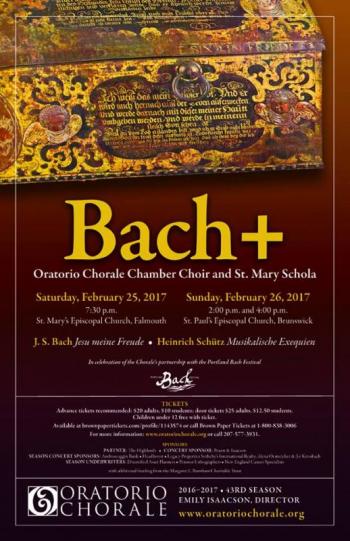Oratorio Chorale honors Bach, Shütz
The Oratorio Chorale Chamber Choir’s early spring production, sung with St. Mary Schola’s choir and directed by Emily Isaacson, performed Saturday, Feb. 25 in Falmouth, and twice Sunday at St. Paul’s in Brunswick, was an homage to Baroque styles. Another Baroque program will take place later in the spring, featuring music of Vivaldi, Victoria and Pergolesi.
This weekend’s program featured Johann Sebastian Bach, with his beautiful and complex motet, “Jesu, Meine Freude,” and Heinrich Shütz, with his “Musikalische Exequien.”
Both pieces are funerary works, similar to a liturgical requiem mass. Both composers were German and lived after the Reformation, and in the Lutheran church, pieces done for funerals were known as exequiens. The Bach piece, however, was not an exequien, but rather, a motet. Motets are vocal pieces that are polyphonic, that is, they have more than one dominant line, and very often, the lines provide their own harmonies in a form known as counterpoint, which is true of all six of the known Bach motets. Several of these were written for funerals, but the motet is not necessarily a funerary form.
“Jesu, Meine Freude,” (Jesus, my joy), is a motet in E minor for five vocal parts composed in 1723 for the funeral of Johanna Maria Käsin, the wife of the town's postmaster. The title and much of the text came from a hymn of the same name by Johann Franck. Some of the text comes from the Epistle to the Romans.
The music is sung from the perspective of the dying person, and as the title suggests, death is not seen as an enemy. Instead, death is welcomed, as it will lead the dying to her entirely expected salvation. Unlike a requiem mass, with pieces sung to have mercy on the dead (“Kyrie eleison,” “Agnus Dei”), and on those who pray for them, and very often, a reminder for those still living (who may have sins to confess) to have the dread of hell in their hearts (“Dies Irae”), Bach’s motet is instead joyful, recounting the reuniting of Jesus with a beloved soul. The dying person is quite happy to put away the things of her life and join in eternal salvation:
“Hence, you spirits of sadness, for my Master of Joy, Jesus, comes here. For those who love God, even their troubles must be pure sugar. Though I endure mockery and shame here already, nevertheless you stay with me even in sorrow, Jesus, my joy.”
The Shütz piece is much earlier than the Bach piece and was written during both the 30 Years’ War, a time of significant religious upheaval, as well as one of the major visitations of the Black Death in Europe. The piece was written for Prince Heinrich Posthumus von Reuss, who died in 1536. Von Reuss collaborated with Shütz on the piece. In the horrific climate of central Europe during the plague years and the 30 Years’ War, death was not something to be feared or avoided; it was a comfort, and the “Musikalische Exequien” exudes that sentiment.
The work is in three parts, and compared to the disorder and death that must have surrounded von Reuss, is peaceful and hopeful. Part One, the Exequien, is the equivalent of the German requiem mass, but there is little in the liturgy that suggests the Latin mass. Much of the text is from the Bible, while other parts come from philosophers and religious leaders of the day, including Martin Luther, Johann Leon and Johannes Gigas. This long part is in 27 smaller pieces. Much of it is sung by intimate groups of singers of all voices.
At the time, it would have been sung by all male voices, and the female parts sung today performed by treble voices of boys or young men. Part Two is a motet, and Part Three is the Canticle of the Blessed Simeon, sung by the Chorus and a trio of two sopranos – singing the roles of the Holy Spirit and the Seraphim, as well as “Simeon,” the role of the deceased von Reuss. They sang in the choir above the nave of the church, while the Chorus remained at the altar.
As with the Bach motet, the theme was a sure and certain hope in the resurrection of the dead. No prayers were required to get von Reuss from purgatory; his salvation was assured by his own belief.
“Blessed are the dead who die in the Lord; they rest from their labours, and their works do follow them. They are in the hand of the Lord, and no torment touches them.”
It was the first time this listener had heard the Shütz work, and although J.S. Bach probably knew nothing about his work during his much later lifetime (Bach was born in 1685, a dozen years after the death of Shütz), part of Shütz’ mastery of the distinction of the beliefs of the Latin and German death customs found its way into Bach’s later funerary works.
In addition to the singers, musical accompaniment was provided by Bruce Fithian, organ continuo, Timothy Burris on lute and Phillip Carlsen on cello.





























